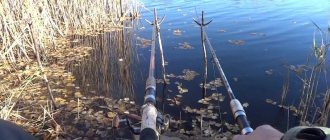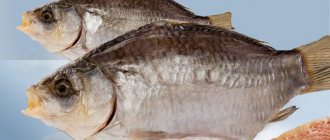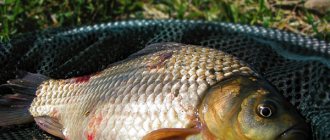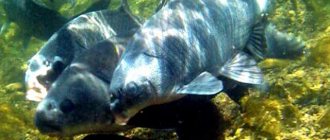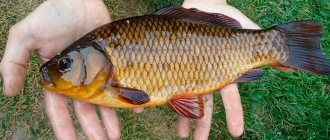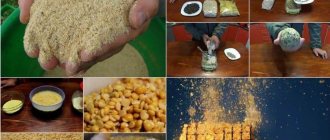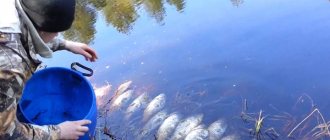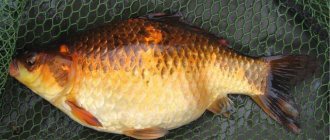Crucian carp - description
The name from Latin is “Carassius”. Its roots are lost in the old German word "Karas". Linguists are constantly debating about this origin of the ray-finned cyprinid order.
The habitat is very wide. It lives not only in Russia (the European part of the Russian Federation, the Far East, the waters of Siberia), northern Asia, some European countries, even the USA knows this fish quite well.
A large carcass with flattened barrels. The smooth shapes of the back form a semicircle. The fin on the back is large and tends towards the tail. The anal one has a difference, like many other species - a small notch. The sides of the crucian carp are equipped with a special sensitive “line” in the middle. With its help, he, like a locator, picks up the slightest external movements. This lateral “sensor” is a pore that is anatomically connected to the internal receptors of the body.
The head is small, the eyes are also small, but have dark expressive pupils. Mouth towards the top. The cavity contains one row of teeth and swallowing fangs.
The entire body is covered with large and smooth scales. The dimensions of an adult individual are 55-65 cm in length, weighing over 5 kg.
By nature, the carp order is characterized by an excellent sense of smell and an average life of 7 - 10 years. A separate subspecies can live up to 13 years.
Crucian fish - species
In the scientific classification, crucian carp are classified as an independent genus, belonging to the family of carp fish. Currently, there are five types of crucian fish:
- Golden (common) crucian carp. It is a native species to freshwater bodies of Eurasia from England to Central Siberia (Lena basin). It has a characteristic yellowish-golden tint to its scales.
- Silver or silver crucian carp. Initially, this species inhabited reservoirs belonging to the Pacific Ocean, as well as in some rivers of Siberia. However, thanks to human efforts, this species has spread widely throughout the water bodies of northern Eurasia, becoming perhaps more widespread than the local golden crucian carp. This species has a steel or silver color and slightly larger scales.
- Crucian goldfish. This purely decorative species was artificially bred in Ancient China by selecting common crucian carp. Today, several breeds of goldfish have been created, differing greatly in both shape and color. The base breed differs in appearance from ordinary crucian carp only in its bright orange color.
- Japanese white crucian carp. Initially, it was endemic to Lake Biwa, the largest lake in Japan. Subsequently, it was artificially populated in Korea and Taiwan. It is distinguished by a light gray color.
- Mabuna crucian carp (Carassius langsdorfii). Widely distributed in Japan, sometimes found in the Far East. Visually, it is very reminiscent of silver crucian carp.
Although some species of marine fish have the common name sea crucian, this fish has nothing to do with real freshwater crucian carp.
crucian carp
Kinds
Based on shape, size, color of scales, and habitat, crucian carp fish are divided into many species.
Goldfish
The gray tint of the silver color is sometimes replaced by grey-green scales of the fish depending on the habitat. The 45 cm long species lives in fresh water for about 7-9 years. The weight of an adult crucian carp is up to 3.5 kg. Fresh river fish.
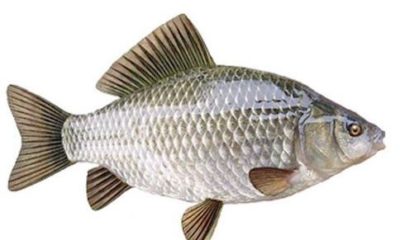
Externally, his body and head form a kind of sharp edge. The scales are very large. The dorsal fin is not convex at the end, but concave inward. This species previously lived even in the Pacific Ocean. Through Siberian water streams it entered European water bodies. Research has shown that the migration of crucian carp was accomplished artificially.
Females spawn together with males of other fish. Together with carp, bream, roach. This means that their fertilization occurs in the absence of male sperm. Then the crucian carp develops by laying eggs. At this spawning, only females produce fry.
Golden crucian carp
Fish with an elongated body. Covered with large scales of a golden hue. A brown or copper tint is visible. Individuals are larger than silver fish. They reach a length of 0.5 m. They are also ahead of the silver ones in terms of mass. On average they gain 5-6 kilos. Life activity is 13 years.
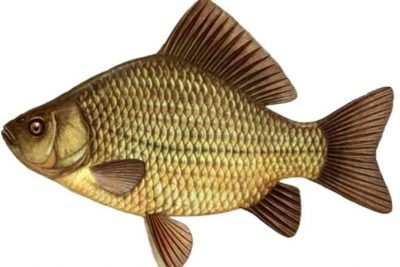
Body structure with a convex dorsal fin. The head of the golden one is unlike its other brothers. It's rounded. The belly is without the usual pigments. It lives mainly in swampy waters of lakes and coastal reed thickets.
Interestingly, golden crucian carp spend the winter individually. In a sleepy state, it buries itself in the bottom silt of the lake. In this position, all the cold sleeps. This allows the type to survive the cold even when the surface of the water is bound by an ice shell.
Scientists note that the depth of burrowing into the silt reaches 75 cm. The fish loves underwater vegetation. If the bottom of the lake is sandy and there is no silt provided by nature, the growth of the species is very slow.
Nautical
It bears the second name “Laskir”. Habitat: Azov and Black Seas. Rarely found in warmer seas. The fish differs significantly from its freshwater “brothers” in appearance. The “weasel” has a different way of life.
Caution and fear are in the first place for sea crucian throughout life. It is very easy for a novice fisherman to scare him off. The marine type has an oblong body. The sides are flat. The color is yellow, the belly shines with silver lighter than the body. A dark-colored spot near the tail feathers of the fish is the main sign of golden crucian carp.

Teeth in rows. First, the wide incisors. Afterwards - chewing.
The size of the individual is small. The most outstanding in length are up to 35 cm. The weight of crucian carp is less than that of river or lake “relatives”. Rarely exceed 1 kilo.
However, the seas are richer filled with living organisms than those of freshwater types. This means that sea crucian carp naturally receives some traits that allow it to live calmly in the salty world. The differences repel many predators when attacked. They are given sharp “rays” of the anal fin. Fish uses them as weapons in conflicts with other water inhabitants. For this reason, fishermen nicknamed the sea crucian “ruffy fish.”
Likes to be located at a small coastal distance. Inhabit rocks and hide in them. During calm periods, schools of weasel go into the sea, to the depths, but rarely move; the fish are mostly sedentary.
There are decorative subtypes of sea crucians (for aquariums). There are subclasses in the sea - “goldfish”, white Japanese, crucian carp mabuna. They are either not intended for fishing, or are very rare in habitat.
Life cycle of crucian carp
The life of any fish begins with eggs, from which fry emerge after 2-3 weeks. During the first two months, more of them become food for fish or do not survive due to lack of food.
If this period has passed successfully, then the small crucian carp begins to grow actively, reaching maturity by 3 years. Of course, the duration of the existence of crucian carp directly depends on its variety and habitat.
Thus, the life expectancy of golden crucian carp is much longer, because he is extremely careful, evades the slightest danger, so it is extremely difficult to catch him, and requires a certain skill from the fisherman.
Silver crucian carp more often becomes the prey of fishermen. But even with its availability, its numbers do not fall, since it reproduces very actively. By the way, if both species end up in one body of water, the silver one will gradually displace the golden one.
Also, if crucian carp lives in places with insufficient moisture, then its lifespan, provided it comes into contact with wet grass or silt, can reach 11 days. The fish will die as soon as the scales on its body dry out.
Habitats of crucian carp
Vast territories distinguish its species from other types. Give the population some advantages. Silver and golden crucian carp love clean fresh rivers, lakes, and ponds. But they can also feel comfortable in marshy areas of water. Where crucian carp still cannot live is in the water of mountain lakes or rivers.
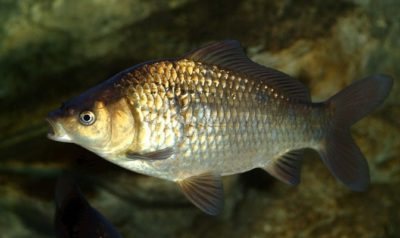
Human labor gave crucian carp life and free development in the waters of Europe. In the East - Poland, Hungary, Romania. In Western - Germany, Italy, Portugal. There is fish in the country of Foggy Albion - Great Britain.
Habitat range: central Russian Federation, Far East, Siberia. CIS countries boast of the presence of fish - Belarus, Kazakhstan, Ukraine.
Crucian carp is found in Mongolia, China, Korea and Japan. In Pakistan, Thailand. In the USA and India. The family covers fresh and salt waters of almost the entire world.
Due to their wild endurance, the habitat of crucian carp is enormous. Some species survive changes in water temperature and difficult wintering. They burrow into the bottom to a depth of 70 cm.
Scientists observed the family of crucian carp, their habitat, and behavior. Based on the following conclusions were drawn:
- the reservoir has a vast bottom with silt - the crucian carp population is growing;
- with silt at the bottom - suspended animation - survival in winter.
The habitat allows many fishermen not only to enjoy the process of catching crucian carp, but to leave fishing with their catch.
Habitat in fresh waters in swampy coastal zones. Where the water warms up faster, there is vegetation and a muddy bottom. It is impossible to find crucian carp at depth.
Marine fish like shallow salty waters during the warm season. In calm conditions it is found in the depths of its flock. In winter, he tries to go deep under the salty water so that the cold cannot kill him. Due to the shyness of the fish, it must be caught in quiet coastal areas. Far from beaches and any other activity. Fish activity is especially high in areas where mountain rivers flow into the sea; there is an increase in oxygen in the sea due to the seething water of rivers from the mountains, which weasels like.
Behavior
The behavior of fish depends on the reservoir and time of year. If this is the only dominant species in the reservoir, then it will bite quite greedily and boldly, regardless of the bait. In this case, there is a risk that the crucian carp will degenerate into a dwarf form.
In lakes and other bodies of water where carp, tench or rudd are present, the weight of the crucian carp will be much greater.
At the same time, he will peck on both plant and animal bait. Only large individuals are able to actively move around a body of water, while violating all boundaries.
IMPORTANT. If a fish is adjacent to a predator, then it becomes much more careful.
At the same time, its weight and length can reach maximum dimensions.
In spring, fish begin their seasonal migration. It begins to behave more actively as soon as the ice melts and the water is saturated with oxygen. The fish unite in groups and move to shallow lagoons, where the water warms up the fastest. Spawning occurs together with roach.
In summer, crucian carp is practically motionless, since there is enough food and it does not need to waste energy searching for it. The second spawning period begins in June.
The end of summer - the beginning of autumn is the period when fish begin to actively move to deeper parts of the reservoir, as close as possible to the wintering holes.
Habitats
Crucian carp is an unpretentious species of fish, so it has a fairly wide distribution area. It can often be found in the following bodies of water:
- rivers;
- ponds;
- lakes;
- swampy bodies of water.
Scientists point out that the more silt there is in a reservoir, the more comfortable the crucian carp will feel. During severe frosts, fish can sink down to 70 cm.
REFERENCE. This species is not found in mountain rivers and lakes.
Thanks to human economic activity, crucian carp lives in water bodies of many countries. It is distributed in the following areas:
- Russia;
- China;
- Mongolia;
- Korea;
- Poland;
- Italy;
- Germany;
- Portugal;
- Hungary.
Some species are found in the cold waters of Siberian rivers. Representatives of this species also live in the waters of Thailand, India, the USA and Pakistan.
Does crucian carp bury itself in mud?
For a comfortable winter, crucian carp buries itself in silt, in which it waits out the cold winter. In this case, the fish survives even if the lake freezes completely to the very bottom. Crucian carp can also burrow into silt during severe drought, when the reservoir almost completely dries up.
What does it eat?
Crucian carp feed on underwater vegetation, zooplankton and small invertebrates. In the absence of sufficient food, it can even consume organic waste.
In the first week after birth, the fry feeds on the contents of its gall bladder. A week later he begins to consume simple microorganisms.
IMPORTANT. The fry's diet is based on bacteria, algae and daphnia.
Only after a month does the fish begin to eat more nutritious food. These can be larvae of water insects and bloodworms.
Adults feed on:
- worms;
- insect larvae;
- cariform;
- root part and stems of plants;
- algae;
- duckweed
If fish is grown for commercial purposes, then its diet may include bread crumb, porridge and dough.
Carnivore or herbivore
Crucian carp does not eat other fish. The main part of the diet is plant foods.
food chain
Such fish are present in the following food chain: algae - crustaceans - crucian carp - pike.
Fish diseases
There are quite a large number of diseases that crucian carp can suffer from. Some of them can be dangerous to humans. Main diseases:
- ligulosis;
- opisthorchiasis;
- rubella;
- ichthyophthyriosis.
Among the cyprinids, a disease such as ligulosis is widespread. It is provoked by the presence of plerocercoids of Ligula intestinalis. They can be located in the peritoneum of the fish, thereby causing atrophy of the internal organs.
Affected fish may become infertile and the abdominal cavity often ruptures, leading to death.
The causative agents are helminths that can grow from 5 to 120 cm in length. They are able to exist in fish for 3 years.
The disease opisthorchiasis is quite dangerous for humans. It occurs due to infection by helminths. In this case, the pancreatic ducts, gall bladder and liver ducts are affected. Crucian carp acts as an additional host.
Sources of invasion are people, wild and domestic animals.
IMPORTANT. Rubella occurs in almost all representatives of cyprinids, including crucian carp.
The disease occurs in late spring or early summer. Sometimes the lesion can occur in winter. Most often, individuals 2-3 years old get sick. Rubella can cause mass mortality.
In acute cases of the disease, hemorrhages, dropsy, ruffling of the eyes and bulging eyes are observed. In the chronic form of the disease, ulcers form on the skin of the fish.
Ichthyophthiriasis is the second most dangerous disease after rubella. Most often it occurs in young individuals. The disease is transmitted from a parasite that lives under the skin of crucian carp. The affected fish becomes lethargic and does not respond to any stimuli.
Crucian carp is susceptible to many diseases. During economic breeding, most of them are easily eliminated with the help of special preparations.
Nutrition
Biologists have established what crucian carp eats - it is a fairly omnivorous fish. The fry, before they have time to hatch from the eggs, fill the gall sacs. This way they will not weaken and will grow to the desired size.
As they grow older, the fish begins to eat plant foods. Algae promotes the growth of fry. As soon as they turn one month old, the menu expands to organic food. Bloodworms and larvae of aquatic insects are used.
Adults feed even more widely:
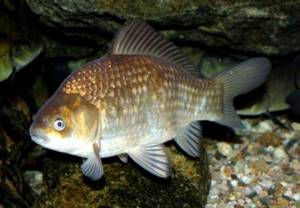
aquatic worms;- small crustaceans;
- larvae of many insects;
- coastal and underwater plants algae.
Frequent feeding of fishermen before fishing, commercial breeding of fish for sale. This allows you to eat fish and boiled cereals. Millet, buckwheat, and pearl barley became a delicacy for her. Doesn't disdain bread balls soaked in butter.
The sense of smell of “fresh” crucian carp is acute. They feel the bait instantly. The food of the carp order in hot times includes the bottom flora and fauna of rivers and lakes. Complementary feeding before fishing increases the number of fish.
In winter, the river and lake species, buried deep in the bottom silt, do without food. Immerses himself in a state of suspended animation. In cold weather, sleep allows him to wait for warmth.
Habitat in the sea - most often coastal zones. A significant portion of crustaceans, plankton and mollusks live there. This organic matter feeds the crucian carp.
Favorite places are sandy areas rich in aquatic vegetation. It eats flora with pleasure, along with invertebrate fauna; crucian carp loves to eat the eggs of other inhabitants, and can eat its own eggs. In winter, the fish go to the open sea, to the bottom. There it balances in warm layers of water. Wintering is similar to freshwater, but there is no immersion in the ground. At the end, the “sailor” is hungry. Reaches for any food. Fishing with bait in the early spring months is easy.
Methods of catching crucian carp
This fish is loved by novice fishermen, as it is not fussy to catch. Catch like a live bait:
- Maggots
- Chafer
- Earthworm
- Bark beetles
- Larvae
Same for plant baits:
- Dough
- Various cereals
- Beans
Crucian carp is not a picky eater, but the choice of bait with which it will be caught depends on what food it lacks in the reservoir.
Crucian carp can be caught differently depending on the season of the year. Best caught in spring and summer.
Reproduction
The fresh species is considered the beginning of the spawning season - late spring - early summer in the central regions of Russia and former USSR countries.
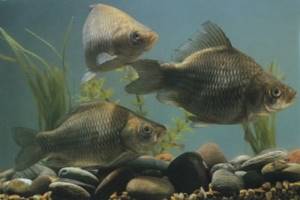
May and June heats the water to 17-19 degrees. It has a beneficial effect on the start of reproduction. Spawning takes place in a couple of parts, with a break of about 7-10 days between them.
Light yellow caviar has increased stickiness. Promotes excellent adhesion of eggs to parts of algae. The female lays about 300 thousand eggs at a time. It all depends on the water temperature. The maturation of the offspring lasts 7-8 days.
The silverfish has a unique spawning habit. In the absence of a male, the female reproduces with the help of “males” of similar species. Milk from bream, carp, and roach does not receive full fertilization, but it provokes the development of eggs in “female” crucian carp. Scientists call this gynogenesis. As a result, females are born.
Artificial fish breeding by private human efforts is popular. The silver species in this is attractive as fishing prey. But the golden species is not inferior to fishing, like a trophy. Crucian carp are also bred on an industrial scale in special reservoirs for sale.
Spawning of the "weasel" begins with the warm season. From late spring until autumn, the marine subclass divides in pairs, reproducing ingenuously and simply. During this period, pairs do not complicate spawning by building burrows or other structures. The caviar clings perfectly to the rocky bottom as it is.
Development and reproduction
Sexual maturity of crucian carp occurs at 3-4 years of age. With plenty of feeding, the fish can become mature as early as 2 years. In the northern regions, sexual maturity occurs several years later.
Crucian carp spawn at water temperatures above 14 °C. Optimal values are 17−18 °C. The female lays eggs in several approaches, the interval between which can be up to 10 days. The spawning itself is quite drawn out. It starts in May and ends only in August.
REFERENCE. Crucian carp can spawn about 300 thousand eggs at a time, and silver carp - up to 400 thousand.
The process of reproduction of crucian carp itself is practically no different from the reproduction of other spawning fish. Females lay eggs, and males fertilize them with milk. The eggs attach to the stems of aquatic vegetation and develop within a week.
Stages of development
Development begins with the adult laying eggs and milk. External fertilization takes place and an embryo is formed. Then a larva emerges, and from it a fry. Over time, it grows into an adult and the chain of development repeats itself.
Caviar development
For normal development of eggs, an optimal water temperature is required - above 14 degrees. It will not develop in a hole. After fertilization, a certain amount of time is required for the incubation period.
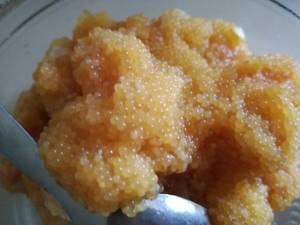
On average, embryos appear in 3 days; in warm water the process occurs faster. The hatched larva is about 4 mm long. Closer to autumn it grows to 5-8 cm.
What affects growth
The growth of fish depends on many factors. It will develop faster in the most comfortable conditions and with enough food. It should be remembered that crucian carp prefers muddy reservoirs.
They contain a large number of small microorganisms that it feeds on.
How long does he live?
Life expectancy depends on the variety of crucian carp. The silver type can live up to 8-9 years, in almost any body of water. This species is distinguished by greater vitality and fertility. Representatives of the golden crucian species live on average about 12 years.
Weight Limit
In industrial conditions, the weight of crucian carp can be about 500 g. Under favorable growing conditions, such fish can gain weight up to 5 kg.
The largest crucian carp in the world caught on a fishing rod
There are many versions regarding the weight of the largest crucian carp in the world. According to one of them, the largest fish was caught by an Englishman. She weighed 42.6 kg. Some experts point out that it was not pure crucian carp, but a hybrid with carp.
The largest in Russia
The maximum weight of crucian carp was recorded in the Pskov region in the village of Osyno. A crucian carp was caught with a length of 54 cm and a weight of 5.6 kg.
How to distinguish the sex of a fish
Females grow much longer than males. They are large in size and can produce a lot of caviar, since their dimensions are proportional to the size of the genitals. In males such dependence is not observed.
Where does it spawn?
Spawning occurs in shallow water. The optimal place is thickets of reeds or sedges. Females rub against plants, thereby laying eggs. Silver crucian carp often spawns in bays and reservoirs.
The golden species of fish prefers to lay eggs in still water or with minimal current.
In the pond, fish begin to spawn earlier, since the water temperature in the rivers is lower.
Commercial value
Freshwater crucian carp lives on almost the entire Eurasian continent and is popular in fishing.
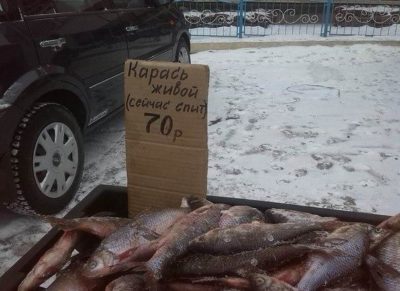
Even ancient man caught it with primitive fishing rods or nets. Fishing for crucian carp is still popular today, there are no difficulties in it, the process itself is original, and the catch is good. The meat is very tasty and healthy.
Private breeding improves the quality of fish and is necessary for single fishing trips. In nature, due to many factors, crucian carp is small. People artificially increase the height and weight of crucian carp through constant feeding and constant feeding. Now catching fish is not only interesting. Everyone wants to taste this delicacy at lunch and dinner.
Fish is industrially bred for sale as a commodity. Its privileges and qualities make breeding a simple but cheap commodity. The volume of individuals plays a high role in the profit of the hatchery fishery.
Calorie content of crucian carp
The frequent use of crucian carp in cooking is due to its low calorie content: 100g of raw meat contains 86-88 kcal. In addition, it contains 30% of the daily value of protein. The best taste is observed in fish caught in June.
With different processing of crucian carp, its calorie content changes. The lowest for a dried product is 59.5 kcal, and the highest for a dried product is 220 kcal.
Due to its low calorie content, crucian carp is suitable for any diet, and also, due to the content of a large number of useful substances, such as Omega-3, calcium, phosphorus, chromium, PP vitamins, etc., has a beneficial effect on the condition of the body, strengthening bone tissue, improving blood circulation, condition of skin, hair and nails.
How to catch
The time to catch comes in early spring. They look for fish in water that has had time to warm up best. The fishing tools include: a float rod, bottom gear such as a feeder and others. Success is ensured in the coastal zone. Even a beginner leaves fishing with prey at this time.
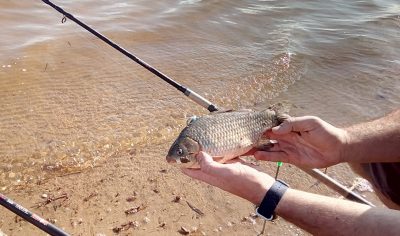
Before fishing begins, the fisherman cooks porridge from cereals (millet, pearl barley), digs for earthworms, takes the bread pulp, soaked it in sunflower oil, and hits the road. The bite is excellent for bloodworms, maggots, and other insects.
The fish's sense of smell is high. Bait and complementary food must be soaked in something odorous - oil, even a fruity aroma.
Experienced fishermen offer excellent bait - fishing with cottage cheese or boiled buckwheat. You should definitely season the bait with essential oil and bay leaf.
Crucian carp not only smells well, but also sees sharply. Using more inconspicuous fishing gear and the thinnest fishing line is an advantage for the fisherman. You can always catch crucian carp in the reeds, where the depth of the reservoir is no more than 3 meters. First, the crucian carp is fed with bread balls soaked in oil, boiled pearl barley, and millet cereals.
Spawning of crucian carp stops fishing for 1 month. Afterwards, fishing for river and lake crucian carp is possible until winter. It is especially successful in the summer, even in the fall. Predator hunters catch small crucian carp to bait large predators with small fish. But most are for the sake of the main loot on the table. The feeling of the process is unique. Winter fishing is unproductive. The fish are hibernating at the bottom in the cold.
Fishing for crucian carp in salt waters is also not difficult. Sea fishing spots are chosen correctly. Calm and deserted. The individual of the sea is timid and cautious. Excess noise only gets in the way. An abandoned dock or pier is an ideal position for offshore fishing.
Weasels are caught in the late afternoon if there is no wind at sea. We need to look deeper for places. By nightfall it becomes possible to catch a large specimen. The gear is not particularly different from freshwater fishing. The most successful is a float fishing rod or spinning rod. Donka, feeder or elastic band can be suitable for daytime fishing in the summer.
When fishing in the dark, the fishing is the same; I use a backlight on the float - it helps to see the bite.
A good bite of sea fish occurs a couple of days before a storm and immediately after it. Sea swells lift a lot of plant and organic food from the bottom, which attracts crucian carp.
How, where, when and what to catch crucian carp
Crucian carp are caught from the shore, with a fishing rod, using all kinds of gear and natural bait.
Read my reports on fishing in Israel - here
5.1. Biting calendar - what time of year is the best time for crucian carp to bite?
Successful months for fishing for crucian carp are June and July.
The best time for fishing is 6 – 9 am, in the evening - before and after sunset. On hot summer days - at 12 - 14 o'clock in the upper water column.
5.2. What weather is the best time to bite?
Crucian carp bite in calm weather or when the wind speed does not exceed 10 m/s. In the cool months, there is active biting in sunny weather and vice versa, in the summer, when it is fresh, the presence of clouds, before rain. During heavy rain, adult crucian carp may eat.
A factor influencing the mood of crucian carp is the jump in atmospheric pressure that occurs during a change in air temperature. In case of sudden cold or warming, you need to wait 2-3 days for the pressure to stabilize.
To know in advance about the zhor on the upcoming fishing, get an aquarium crucian carp at home. Before leaving for fishing, throw some bread and the reaction of the domestic crucian carp will correctly tell you about the nature of today's bite.
5.3. What are the best places to fish?
Crucian carp are found in secluded places that serve as shelter and food for them - these are holes, reeds, mud, algae, and water lilies.
An ideal place for crucian carp
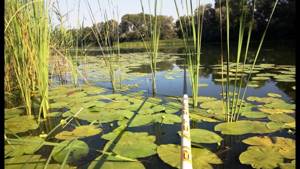
5.4. What gear is best for catching crucian carp?
There is a huge amount of gear for catching crucian carp; below we will describe those equipment that have been tested by time and to this day remain effective and in demand among experienced fishermen.
Fishing for crucian carp on a float in the Russian pond, where the fisherman shows and talks in detail about groundbait, lures and the nature of crucian carp bites
Catching crucian carp with a float In summer, crucian carp is caught with a float, most often with a fly rod, 4-7 m long and, as a rule, without a reel.
The primary focus is on the float. It should be:
- sensitive;
- not bulky;
- with low dough 1-5 gr.
Read a detailed article about the float, its components, their purpose and characteristics, get acquainted with the description of the whole variety of shapes of fishing floats and their purpose - here
An exception may be when you need to make a long cast in a deep reservoir, but this is a completely different fishing, since bites are possible, not only for crucian carp.
A buoy is attached to a 0.20 mm fishing line with a carabiner and secured with stoppers on both sides. Below, along the main line, pellets of different weights are distributed, from the float in descending order. The rig is completed with a leash with hook No. 5 (hook width 5 mm), tied on a mini swivel. The load of any float is individual, depending on weather conditions and distance from the fisherman. It is more correct to load the buoy so that the antenna of the buoy looks above the water 4 cm, during wind and waves 6 cm.
Photo of float tackle
Read all about how to correctly and securely tie a fishing swivel to various types of fishing lines, elastic bands, etc., in which case it is best to use one or another knot and know how to do it - read here
In spring, autumn, in clear water or when crucian carp are especially cautious, it is best to use 0.16 mm invisible line and 0.12 mm fluorocarbon leaders. Sliding sinker, sliding distance 7 cm and additional pellet near the undergrowth. The float is selected with 1-3 grams of dough, made of balsa, goose feather or linden material.
You can make a quill pen yourself, and it will be many times better than a factory one. Carefully cut off the fibers from the feather with scissors, cover with white varnish and, after drying, re-paint with firefly varnish, and for brightness, paint on the stripes with red acrylic paint. Now the float will be clearly visible during the day and at dusk.
Photo of dyed goose feathers
To make a quill feather sliding, you can apply a connector (size L) to it, after carefully sharpening the lower part of the feather. You can also attach an eyelet made of a steel needle at the bottom of the feather.
The float connector is a special device for floats that do not have attachment points in the keel area. The base into which it is mounted is rubber, the swivel with an insert is copper or steel. Available in sizes L, M, S.
Connector photo
Photo of a homemade eye made from a steel needle
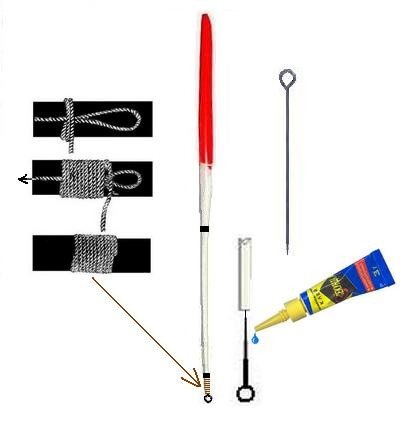
Here you can find a selection of the best deals on fishing products we found on the aliexpress website. Thanks to this catalog, you can reduce the cost of installing gear by 2, and sometimes 5 or more times. You will find a detailed description of various products, their characteristics and justification for the benefits of purchasing them. And if you spend 10 minutes and learn how to use cashback, you can additionally save up to 15% on all purchases in a Chinese hypermarket.
When all the accessories are ready, it’s time to assemble the ultra-sensitive float tackle for crucian carp. First of all, the float-feather is attached; if it is a “blind” installation, then on a cambric, if sliding, then on a mini swivel with a carabiner. The sliding float is fixed from below and from above by limiters. Then a sliding sinker “olive” is passed through, which is also blocked by stoppers on both sides. The last thing in the rig is the undergrowth with hook No. 4, and in front of the leash, an additional pellet is pressed - the undergrowth.
Now, at the slightest touch to the hook, the additional pellet will cause vibrations, which will instantly appear on the bite alarm. In the event that a crucian carp pulls the bait with a hook and even if it immediately lets go, it will hook itself: the sub, due to the inertia of the sliding load, will return back and hook the lip of the crucian carp.
Who doesn't know yet? You can return up to 15% of the price of your purchase on aliexpress. In addition to Aliexpress, the possibility of cashback (returning part of the money) also works for many other online stores. Here is a detailed description of this service and everything about how to work with it. It really works and helps you save a lot of money. The cashbacker website often runs promotions that allow you to buy goods at a discount of up to 90%.
Catching crucian carp with a jig The rod most suitable for fishing with a jig is the Bolognese type, without rings, 6-7 m long and with a fast action. There is no need for a reel; the equipment is wound onto the reel.
Many fishermen mistakenly fish with winter jigs, which do not “work” in summer, but only scare away fish with their bright colors. Summer jigs should be gray, dark green or black. Shapes: drop, ant, pellet, banana, uralka, bug, devil, witch.
Photos of jigs

The fishing line is chosen no thicker than 0.18 mm; if the cord is braided, 0.10 mm is suitable. The weight and diameter of the jig depends on the depth of the reservoir and the size of the expected catch. At a depth of 0.5-1 m, use a jig weight of up to 1 g. In places where the depth is 1-2 m, they fish with a jig, up to 5 g. On average, jigs No. 5-7, 3.5 g are used.
If in winter fishing they try to use heavier jigs, with a quick immersion in the water, then in summer fishing, the opposite is true - crucian carp bite more effectively on a slowly and smoothly descending jig. In summer, it is best to make vertical retrieves, in spring and autumn, frequent bites of crucian carp on horizontal game.
The 7-minute video shows a close-up of knot options and how to properly tie a summer jig for crucian carp.
In calm weather, in clear water and on a light jig, a sensitive lavsan guard is used as a bite alarm, and on a heavier jig, they place a harder guard.
Photo of lavsan lodge
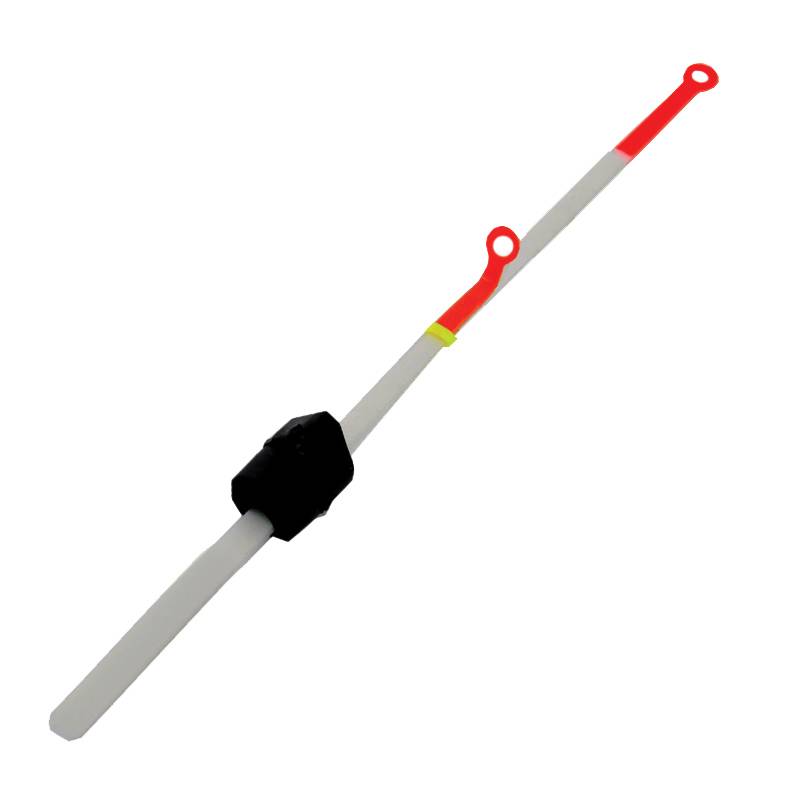
A guardhouse is a mini nod, which was originally used for ice fishing, but with the advent of the summer type of jig fishing, guardhouses began to be made for summer fishing.
Fishing for crucian carp with a feeder For fishing with weighty gear, such as a feeder, donka, top rod and springs, you also need a “stick” of the appropriate structure. It is advisable to use a plug rod, medium class, 3.9-4.20 m long, 3-3.5 lb test. Inertia-free reel, spool size 3000-5000, three or more bearings.
Large crucian carp are mainly caught on the feeder, in deep reservoirs and from the bottom. The tackle is assembled from 0.50 mm wicker material, green, black or leadcore.
Leadcore is a soft lead rod in a braided braid. Sold by the meter or in finished loops 50-70 cm long. It is used in many installations, does not get tangled when casting and fits on any bottom topography as needed.
Read the article about braided fishing line and you will learn about what it is, get acquainted with its characteristics and advantages, learn the features of its use in fishing, care rules and learn how to knit the most popular and reliable knots - here
Find out about the secrets of choosing braid in this article
There are many types of feeder feeders, for example

Consider a popular and catchy installation, with a rectangular black feeder

Installation consists of:
- feeder feeder 30-60 g;
- insert braid length 50-60 cm 0.30-0.40 mm section;
- immediately knit a swivel with 10 kg dough, to which the leash will be tied;
- It is advisable to cover the knot on the swivel with heat-shrinkable tubing, then string a stopper and an additional rubber bead, which will muffle the sound from the impact of the feeder when casting.
- after the bead, a tube with a carabiner is inserted against twisting to secure the feeder;
- on the reverse side, the feeder tube is also fixed with a stopper, and a swivel is knitted with 30 kg of dough, which will be connected to the main fishing line or cord;
- the leash for the feeder should be 20-25 cm long, 0.16-0.18 mm in diameter, made of wicker material, impregnated with carbon fiber. Such undergrowth will not get tangled and will withstand the temperament of any crucian carp;
- a hook No. 8-10 is crocheted in such a configuration where the head of the hook is concave towards the sting.
Don't miss a single detail when preparing a catchy installation? Then this article is for you. Read about fishing stops, their types, shapes, methods of attachment to various fishing elements - here
Photo of the ideal hook for feeder tackle
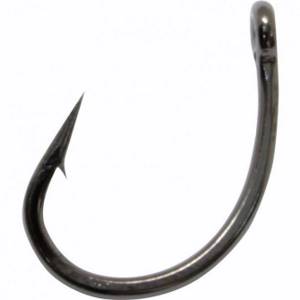
Feeder installation photo
The most detailed article about fishing hooks is here
Catching crucian carp with an elastic band This method of fishing differs from other rigs and at first glance may not seem convenient for fishing. In terms of catch quantity, it significantly exceeds other gear. It is important to tie the tackle correctly with an elastic band and adhere to the necessary details described in this section, and perhaps then this tackle will be your constant fishing companion.
Photo of tied tackle - rubber band

The length of the tackle is determined depending on the width of the reservoir; if fishing takes place on a narrow river, the elastic will be shorter and there will be no more than three hooks; if there is a large fishing area, then the elastic will be knitted for more than 100 m.
Let's look at the gear option that is most often used by fishermen, with a total length of 70 meters. Before assembling the installation, you need to prepare the components:
- 10 m of high-quality rubber, round, diameter 3-4 mm, 1×4 (1 m of rubber stretches by 4 m);
- main line (length 20 m) 0.30 mm;
- for stake (length 10 m) 0.25 mm;
- for undergrowth 0.16 mm;
- rope (length 2 m) 4-5 mm; hooks No. 5 with a long shank (7 pcs);
- sinker, flat shape, 250 gr.
To the betting line, leashes 20 cm long are tied, in the amount of 7 pieces, in the interval of 45-50 cm. In this case, they will not touch each other. The distance of the first undergrowth from the edge of the stake is 50 cm. To prevent the hooks from getting tangled during casting, cambrics are threaded onto the fishing line into which they are inserted. Swivels are tied on both sides of the bet.
The hook for the elastic band is selected with a straight shank and an even tip, 3 cm long
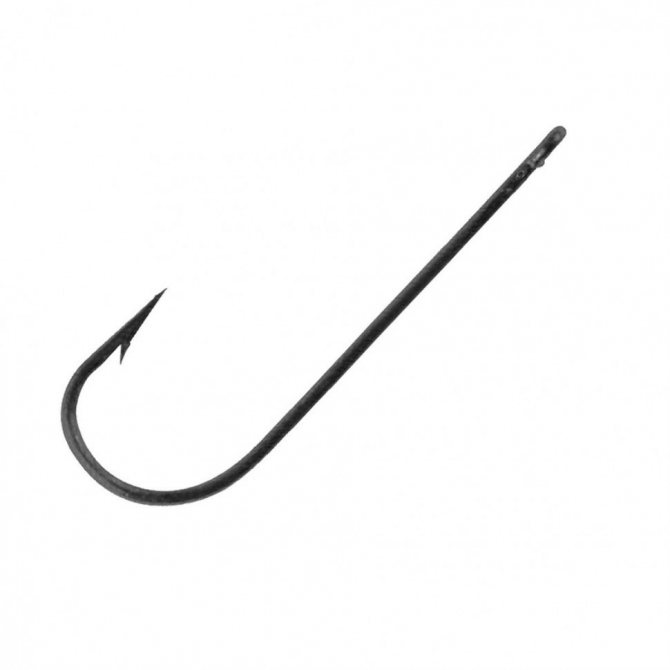
The wall of the stake, where there are no leashes, is connected to the main fishing line, and the other edge is connected to rubber. The sinker is tied to the elastic with a rope https://fb.ru/misc/i/gallery/65070/2463324.jpg
Installation of gum is brought in by boat or thrown from the shore. They cast mainly with their hands or with a spinning rod, so the tackle is fixed on the shore with a reel stuck into the ground or the spinning rod is installed in a vertical position. As a bite alarm, hang a bell on a stretched fishing line.
Place the bait after casting, pulling the main line up to the level of the undergrowth. After which, gradually and carefully release the fishing line, returning it to its previous position.
How to pull out a tackle with a sinker:
- standard option: the tackle itself, but sooner or later the rubber will break and the sinker will remain in the river.
- attach an additional safety cord to the load, and use it to pull it out.
- in the case of the delivery of elastic, a buoy is tied to the sinker, which remains on the surface after the tackle is immersed. At the end of fishing, the equipment is removed from the water by the float.
Adviсe:
- attach leashes, preferably between two beads tied in advance to the stake;
- 30 cm from the first undergrowth, make a loop. Before attaching the bait, this loop is hooked onto the protrusion of the reel so that both hands are free;
- For maximum catch, it is recommended, in the area of the first and last undergrowth, to thread one “dummy” spring onto the bet. The feeders are filled with bait while baiting the hooks.
Fishing for crucian carp on a makushatnik Tackle that came to us from the past. True, she has undergone external changes, but the essence of her work with crucian carp remains the same. There are countless assembly options and no one can say which is better.
We will install the initial installation, tested by fishermen over the years:
- The sinker must be at least 40 grams, lead, rectangular in shape, called a “hoof”.
- The main line is fixed to the threshold of the load; there is a hole in it. You can also pass the fishing line lower in and tie the loop with a slip knot, then with it, the top briquette will be fixed.
- The load and cake are additionally clamped with an elastic band cut into rings from a bicycle inner tube, 5 mm wide. During the disintegration of the briquette under water, the rubber will press the cake to the load more reliably than any clip.
- An important element of the tackle is the hook, it should be wide, the tip and fore-end should be even

- The leashes are knitted from a braided cord 0.20-0.25 mm, 10 cm long, 2-4 pieces. They are threaded through the holes along the edges of the “hoof”.
Catching crucian carp with a pacifier. Any feeder is often mistakenly called a pacifier, and it does not matter whether it is a “flag”, “watermelon” or “dummy”. Initially, a pacifier was a triangular-shaped spring stuffed with mason jar. Fish, in order to enjoy the aromatic food, sucking, often by accident, fell on sharp hooks. This is how the saying appeared: give the crucian carp a pacifier
The principle of knitting feeders is the same for almost all, where three leashes with a hook of different lengths are used. The long leader on the swivel is at the bottom of the installation, the middle one is on top on the outlet, the short one is on the spring.
The nipple differs not only in the fishing method, but also in the assembly method; all leashes with 5-10 hooks are attached to the spring from the inside, and protrude outward by 5-7 cm.
A round sinker of 20-50 grams is passed onto the main leash, which is a braided cord 50 cm long. On the spring side, a mini swivel is tied to the cord, and on the main line side, a swivel with a larger carabiner is attached. The leaders are knitted from hard woven material 0.18 mm, the hooks are self-cutting - the point is slightly concave to the fore-end No. 5-7.
Suitable Hook Configuration
Tackle “Crucian Killer” This tackle appeared quite recently and has already gained popularity in the world of fishing. In fishing stores you can find factory-made “crucian carp killer” equipment, assembled in different ways: using steel bends, braided cord, snakeskin and even leadcore are used as the main material.
In fact, it is better to knit a “crucian carp killer” from shoe nylon thread, brown in color. The property of nylon is most suitable for tying gear with three springs. The assembled equipment will be approximately 35 cm long, but before assembly, you need to unwind the extra 20 cm so as not to “huddle” during installation. Centimeters also take beads and knots for swivels with a carabiner.
The most detailed article about carp hooks, their shapes, parts and sizes is here
For the gear you will need:
- 3 springs 3.5 x 1.5 cm;
- 6 beads (color: transparent, green, red);
- 2 swivels with carabiners;
- braid 0.16 mm 1 m;
- 3 forged self-cutting hooks No. 5-7;
- drop sinker on a swivel or ring 20-35 g.
How to weave beads: the edge of the thread is threaded into the hole of the bead, stretched about 15 cm, this is to leave 10 cm for the beginning of the tackle. Then again this edge is passed into the bead and not fully tightened so that the thread does not fit tightly to the beads, but the loop stands out. Now the edge of the thread is passed into this loop and again, do not tighten it completely, so that from this curl you leave a loop, and tighten the previous one and do this 4 times.
Many fishermen knit beads with three loops and then they have springs that move all over the gear. Because of this, fish often fall off and after each landing, the feeders need to be constantly adjusted.
After the bead is tied, a spring is inserted and the beads are knitted again, almost tightly. Leave a stroke for the feeder between the beads of 1-2 cm, and the distance between the feeders is 5 cm. When 3 springs are already mounted, swivels with carabiners are tied along the edges. Carabiner for weight, placed with 10 kg test, for swivel, on the main line side 20 kg.
Leashes with hooks are knitted 4 cm long with loops. They are attached to the springs by threading the hook through these loops. The leashes should be on the spring - closer to the load. Even if the crucian carp does not bite, it is nearby, pulling out the tackle, and the hook will “take” it with it.
Photo of the crucian carp killer tackle
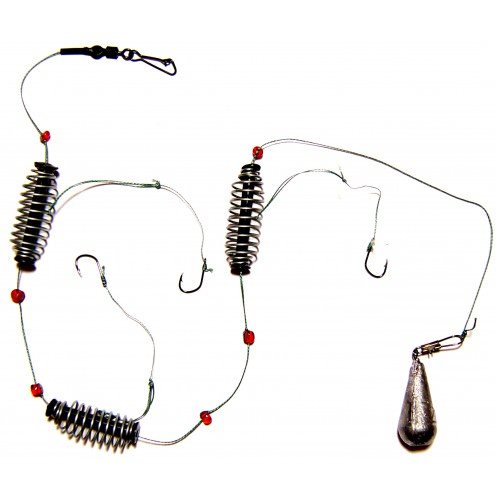
If you learn to combine the listed gear, then the fish tank will never be empty, even when there is no bite.
5.5. Baits for catching crucian carp
A universal bait that is suitable for luring crucian carp and for clogging feeders. Necessary ingredients: pearl barley, millet, barley, corn, vanillin and flavored oil for salad.
Preparation:
- Place water and bring to a boil.
- Add dry pearl barley at a rate of 1x3 relative to water.
- Turn the heat down and cook until the water becomes cloudy and the pearl barley doubles in size.
- Add millet, equivalent to twice as much pearl barley, mix.
- Add a pack of vanillin and add 1 tbsp. a spoonful of flavored oil.
- Stir again and continue cooking over low heat.
- Cook until the porridge absorbs a significant part of the water and gurgling bubbles appear in it.
- Then put out the fire and leave the porridge under the closed lid to absorb water and increase the grains.
- The porridge is ready.
- We move on to the second stage of preparing the bait: now pour the porridge into a clean enamel bowl and pour in the barley and corn grits, each in a ratio of 1x2 to pearl barley and mix thoroughly. The added cereals will absorb the remaining moisture and the porridge will turn out crumbly, and when squeezed, it will stick together.
If the viscosity is not enough, for example, the mesh in the feeder is too large and the bait falls out of it, then a little less barley and corn grits are added. By adjusting the proportions of the grains, you can get plasticine or, conversely, granular bait.
When buying ready-made bait in stores, you need to pay attention to the packaging, on the outside of which there is information about what type of fish the food is intended for. On the reverse side, the added ingredients are described. Often manufacturers do not indicate everything in the description, due to counterfeiting, competition and so as not to reveal their secrets. If you repeat what is written in ready-made store-bought bait, you are unlikely to get porridge of the desired consistency. The information is described in general terms only. If, for example, hemp is added, then the bait is oriented to increase the appetite of the fish, if caramel is for attraction, if flax is added, it is for quick digestion of the eaten food, so that the fish is always hungry.
To fish with a spring, you need to buy bait with the inscription on the package - feeder or with a spring pattern
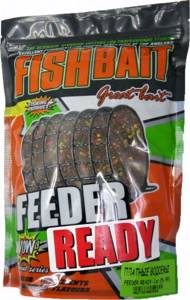
If the purchased bait does not have the required stickiness, then you will need to buy an additional stick (a binding component that gives the food viscosity). Proportions with food, 100 grams of stick per 1 kg of bait.
Photo of the stick
5.6. What baits and baits to fish with
Crucian carp is fickle in its taste needs, today it loves one thing and tomorrow another, but there are baits that it never changes. This section will be about them.
For maximum catch, the hooks of the float rig are baited with the following baits: maggots, worms (earthworms, dungworms, dendrobena (pieces), bloodworms, black bread, piglet balls, semolina.
Crucian carp loves semolina, and in order to use it as a bait, you need to learn how to make a sticky mass from semolina so that it does not fall off the hook. In this 9-minute video, watch how to properly prepare semolina dumplings.
They use a jig to catch crucian carp using peas. You need to buy ready-made peas in a glass container, and not in a can, because you can see not only the production date and expiration date, but also the bottom. In a quality product, the bottom will be free of precipitation.
The best attachment is when you bought peas yourself and cooked them. When making a purchase by weight, you need to ask the seller what year the harvest is, if this is the year, the peas are infused in water for 6 hours, if the previous year was 8-10, but a day is better. Cook over low heat for 30 minutes, last year’s for 1 hour. Properly cooked peas are almost overcooked and when pressed, they fly out of the skin like rubber. Such peas will not fall apart when placed on a hook and will stay on it for a long time.
You need to grab the peas, with the sting under the spine, so that the tip barely peeks out.
Photo of peas on a jig
In a feeder rig, they are effectively caught using a sandwich of peas, corn and pearl barley, placing them on the hook at the same time. To raise the hook with baits, sometimes it is necessary, for example, because of the overgrown bottom, use a large foam ball, dark green, yellow, burgundy.
Photo of a large foam ball
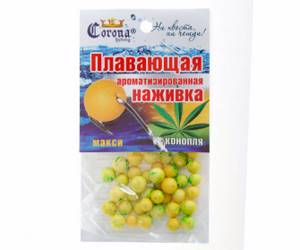
In the bottom tackle there is an elastic band, mainly baited with hooks - a worm, maggot or large bloodworm.
In the makushatnik, foam balls with the aromas of hemp, honey or tutti-frutti are planted and the tip of the hooks is driven along the edges of the makukha briquette. As the cake breaks down, the foam nozzles lift the hooks and the fragrant balls mix in the resulting food cloud.
Fishing on springs, “crucian killer” and “nipple”, a foam flavored ball with bait is placed on the hooks: a red worm, maggot and semolina. The best bait in terms of catch results is corn popcorn produced by the Hungarian company cukk with the addition of garlic or honey. When equipping springs in this combination, you need to take care of a spacious cage.
Photo of popcorn cukk garlic
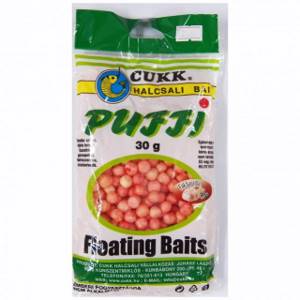
Photo of popcorn cukk honey
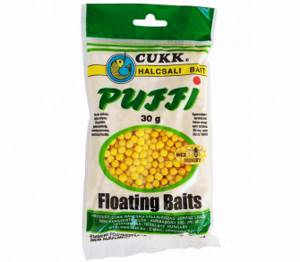
5.7. How does it bite?
The bites of crucian carp are not constant, they depend on how hungry it is and what size it is. 100-300 gr. A crucian carp can move the bait until it is accidentally caught, but then another fry will start moving the buoy again. Misses will allow you to adapt to what moment you need to hook. It happens that while the float is moving, you pull out the tackle, but there is no one on the hook, or vice versa, when there is no bite, you fish for crucian carp with a deep-swallowed hook.
An adult crucian carp, when hungry, pulls the bait quickly and confidently, and then stops - it tries the bait, but does not swallow it. The unpredictability of crucian carp forces the angler to always be careful. After the bite you need to wait for the outcome. It is necessary to fish when, after movement, the buoy goes under the water, lies horizontally or rises up.
5.8. How to fish correctly. — Basic techniques
They hook the crucian carp quickly and just as quickly pull it ashore, not allowing it to swim into the reeds or wrap itself in mud. With a heavy viscous mass, the crucian carp will be many times heavier, which can promise not only a break in the fishing line, but also a break in the rod.
5.9. The most important points when catching crucian carp
Crucian carp is constantly in the grass, mud, reeds, and you have to throw the tackle in those places where the fishing line gets tangled, algae sticks, which makes fishing much more difficult.
Before fishing, it is important to clear the intended places for casting. The mud is removed with a long thick stick, making a 2x2 m window in the green carpet. The reeds are cut with pruners to avoid hooking.
How to clean crucian carp?
Freshwater or sea crucian carp is a food rich in microelements and fatty acids. Vitamins, proteins. Cooking fish dishes is quite rich in options. But first, any fish must be cleaned of entrails and scales. Proper cleaning of crucian carp scales is a small waste of time and effort. Divided into two stages:

Preparation: clean the fish fresh or frozen. Fresh is still alive. She is silenced by a blow to the head with the handle of a knife. Defrosting is carried out at room temperature, but not completely. Wrap in parchment, bag, sprinkle with salt. Afterwards, the fish is rinsed with a water jet and all mucus is removed.
If the individual has a strong mud smell, you need to dip it in a salt solution for 30 minutes. Then rinse with boiling water. A 1/4 vinegar solution is effective against swamp smells.
To efficiently remove entrails and scaly cover, you need cutting tools:
- fish cleaner - a special installation, with or without a container for scales;
- a fillet knife - a boning cutter will also work well;
- chef's scissors;
- tweezers with wide jaws for bones.
With them the process will be simple and effective.
The second stage of cleaning crucian carp:
- The dorsal fin is cut out with chef's scissors. During the process I use a napkin;
- after cutting, the fin is removed starting from the tail to the head;
- the scales are removed - after cutting the dorsal fin freely;
- the insides are cleaned until the carcass is completely empty;
- Now the crucian carp is washed in cool water, several approaches;
- All blood residues are removed from parts of the carcass;
- the carcass is cut into portions for filleting;
- Use a colander to remove any remaining liquid from the portions.
Lifestyle of crucian carp
Crucian carp are unpretentious fish. They survive very well in stagnant bodies of water. On the contrary, they do not like water with strong currents, since they cannot cope with it and become defenseless against other predators. They love mud, in which they can eat and hide. In severe frosts or drought, crucian carp burrow deep into the silt and wait out these troubles. There have been cases when live crucian carp were dug out from the silt of a dried-up lake. It is very difficult for them in reservoirs with a sandy bottom or with a strong current. Most often, in such conditions, they are destroyed by stronger fish. The crucian carp has a very developed charm. He is able to hear smells from quite a distance. He also reacts very quickly to any change in the water around him. The sideline helps him with this.
Description
Silver crucian carp is a fairly well-known fish, which at one time spread from the Amur basin throughout almost all of Eurasia. The object of amateur fishing has commercial significance.
External signs
Medium sized fish. It has a short, laterally compressed body, less tall than that of the goldfish. The number of scales in the lateral line is from 27 to 31. The gill rakers are long, their number is from 39 to 50. They are flexible and can form variations in color and some other external characteristics.
The scales of the goldfish are gray-silver, with a slightly dark, bronze-greenish back. Sometimes you come across individuals with a pronounced yellow tint, almost indistinguishable from golden crucian carp.
Dimensions, weight
Typically, catches contain specimens up to 20 centimeters long, weighing no more than 350 grams. The maximum size that crucian carp can reach under favorable conditions is approximately 40 cm in length and weighs up to 2 kg.
Despite the fact that silver carp is usually smaller than gold carp, it grows faster than the latter.
Similar fish
A related species, golden crucian carp, has much in common with silver crucian carp. Also similar to it are representatives of the Chukuchan family, for example, largemouth, smallmouth and black buffalo, which differ from crucian carp by a more pronounced notch on the dorsal fin.
Young fish of the scaly form of carp also resemble silver crucian carp in appearance; they can be distinguished from the latter by the presence of antennae and a more elongated muzzle.
Anatomical features
The pharyngeal teeth are double-rowed, 4 on each side. The length of the intestine is approximately twice the length of the body.
Secrets of fishing
In order to catch a large crucian carp, you need to pay attention to the following factors:
- habitats;
- special gear;
- features of the bait;
- types of bait;
- fishing style.
Habitats can be viewed on fishing forums. Among them, the key ones are the following bodies of water in the world: lake. Sebezhskoye, Dnieper, some rivers in China, Lake Ivanovskoye.
You need to catch crucian carp in still water, preferably near bushes.
To catch crucian carp, you must have the following types of gear with you:
- light fishing rod with a float;
- a bottom fishing rod for fishing in the dark;
- light float;
- small weight for both fishing rods;
- hooks: Russian No. 3-7, foreign -10;
- medium thickness fishing line;
- the leash is smaller in diameter than the fishing line;
- special fishing net;
- feeders for night fishing;
- a bucket to put the fish in.

The best type of attachment to use is the “bullet” type. There are no specific types of bait. An assortment of nozzles are suitable for different bodies of water. There are several types to try:
- you need to string the dung worm from the head;
- less popular with the common earthworm;
- the most common type of bait is maggot;
- bloodworms can only be used when it is cold outside;
- caddis flies are used as bait in summer;
- Burdock moth larvae are used in the spring.
The following can be used as bait:
- cooked pearl barley with a little honey added;
- pea porridge, which is thick;
- semolina with the addition of various components will be effective in warm weather;
- mastyrka for bait, there are many recipes for this type on the Internet;
- bread pulp;
- cooked oatmeal;
- boiled corn;
- special dough.
Rules for successful fishing for crucian carp:
- choose the right tackle and fishing rod;
- be able to identify a body of water and the place in it where there are crucian carp;
- have enough patience;
- It is unlikely that you will be able to catch a fish quickly;
- observe a special variation of fishing.
To catch large fish as quickly as possible, you need to follow the following fishing technique:
- Find the path of movement of crucian carp. To do this, you can try fishing on one body of water in different parts of it and determine where there are more fish. It’s easier to look at the fishermen around and choose the same fishing spots as them. Most often, crucian carp live in reeds.
- Give plenty of bait and wait a little.
- Prepare all the necessary baits and begin alternately trying to throw them into the pond. There should be a lot of gear, since crucian carp is a rather unpredictable fish.
The secrets of good fishing are common to all species:
Maintain maximum silence. All fish behave quite carefully, they are very shy. If there is noise, fishermen will not be able to catch their catch. It’s better to even try not to talk to each other near a pond.
You should not wear bright clothes; it is better to use special camouflage. This color may scare away fish.
Crucian carp behave differently throughout the year:
- these fish prefer to feed in the dark;
- prefer not to create big shoals;
- usually swim closer to the bottom;
- they are less active than small fish species;
- after spawning there is an additional decline in movement, crucian carp go to rest;
- in spring, fish are active in the first 2 weeks of March;
- In summer it is better to catch fish at dawn or sunset;
- in autumn, maximum activity is observed for almost 24 hours;
- In winter, in many reservoirs, this type of carp hibernates.
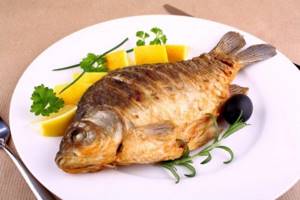
Artificial breeding of crucian carp
From the point of view of a fish farmer, crucian carp is good because it is almost not susceptible to infectious diseases and, as follows from the description of the crucian fish, it is not at all picky about the quality of water and is able to quickly gain everything even without feeding. Although golden crucian carp is a native species for most of Russia, silver crucian carp is better suited for artificial breeding and rearing. It gains weight faster and is generally more durable.
Crucian carp can be bred both in monoculture and together with carp. The easiest way is to buy fingerlings from a fish farm (almost every region has farms that breed crucian carp since Soviet times) and then grow them to commercial size in your own pond. Moreover, the size and cleanliness of the pond are not particularly important. The main thing is to observe the planting norm and not allow the pond to dry out.
If the pond is rich in vegetation and invertebrates, then the fish will feed themselves on their own. But to speed up the process of gaining weight, it is better to feed crucian carp with steamed grain, unsalted porridge, pork feed or feed specially designed for crucian carp. With this regime, crucian carp will grow to market size in just one season.
